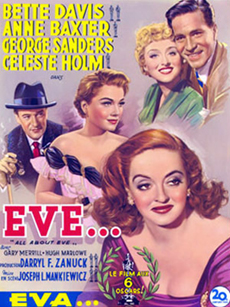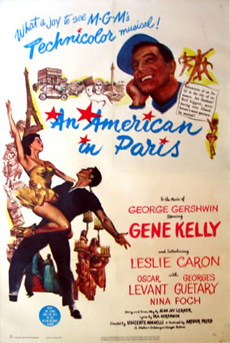I watched All About Eve years ago because it starred Bette Davis.
This was in the phase where I was trying to watch movies featuring the
greats of Hollywood's golden age.
Bette Davis plays Margo, a stage actress whose star is fading, while
her protege, Eve (Anne Baxter) is beginning to rise. The young actress,
at first seemingly sweet, uses her position to gain connections and
benefit her career at the expense of her mentor. It's an old story in
Hollywood, and it sounds a lot like what happened behind the scenes
in Grand
Hotel between silent film star Greta Garbo and a young Joan
Crawford.
The movie is an enduring classic, well-crafted and superbly acted.
It's worth seeing, for the way both actresses transform over the course
of the film. Sadly, its commentary about youth worship in entertainment
remains all too true.

Rating (out of 5): *****
An American in Paris won the Best Picture Oscar
over Decision Before Dawn, A Place in the Sun, Quo Vadis and
A Streetcar Named Desire. The film features 11 songs by George Gershwin
and has the distinction of being the first color movie to win Best Picture.
The movie tells the story of Jerry Mulligan, played by
the charming Gene Kelly. Jerry is an Army veteran who, following the
war, stays in Paris to make a name for himself in the art world. His
best friend is an unemployed concert pianist, Adam Cook, played by the
caustic yet talented Oscar Levant. Adam is the accompanist for singer
Henri Baurel, played by French singing sensation Georges Guétary.
Unbeknownst to them, both Jerry and Henri fall for the
same girl, Lise Bouvier, played by French ballet dancer Leslie Caron.
Gene Kelly discovered her while vacationing in Paris, where he saw her
perform in a ballet. At the time, Kelly was searching for a co-star
to replace Cyd Charisse, who had discovered she was pregnant. He pressed
for Caron, believing that the movie should have a real French girl playing
Lise, rather than an American actress pretending to be French. The movie
was Caron's motion picture debut.
The movie, of course, is filled with song and dance. No
surprise: Kelly is a delight to watch. His dancing with Caron is equally
fantastic, melding Lise's shyness with Jerry's exuberance.
While she's dancing, Leslie Caron seems more mature, more
womanly, as opposed to her otherwise childlike demeanor. At the time
the film was made, she was 20 — and even younger, 19, in the script.
Gene Kelly was 39. The disparity in ages is initially a little jarring,
but after they dance together, it seems clear that, at least in the
world of the musical, they are meant for each other.
Also competing for Jerry's affections is wealthy heiress
Milo Roberts, played by Nina Foch, who at the time was 27, although
she looks older than Gene Kelly, perhaps due to a skilled makeup artist.
She sponsors Jerry's work, ostensibly to further his career but also
in hopes he will fall for her. This is not something that interests
him, and he distrusts the relationship from the start, only falling
back on Milo when it seems as if his true love is unattainable.
Foch has a thankless role, to be sure. Milo is transparently
needy and desperate, which clouds her otherwise stunning beauty. In
any other movie, Foch might have been the romantic lead.
Oscar Levant is engaging as Jerry's piano-playing friend.
While Jerry is optimistic and perpetually sunny, Alan is the perfect
counterpoint: acerbic and self-deprecating, launching asides in a deep
baritone growl. Musically, the two blend their styles well, seemingly
feeding off each other and making their duets feel like a creative improvisation,
with Kelly launching into inventive dance sequences.
For me, the dream ballet sequence that closes the film
was particularly interesting. This intricate 17-minute extravaganza
inspired my high school marching band's greatest hour. Our field show
that year incorporated music from An American in Paris, and our
choreography evoked the movement and color of the dream ballet.
The ballet takes place in front of backgrounds meant to
evoke Impressionist painters, namely: 'Raoul Dufy' (the Place de la
Concorde), Edouard Manet (the flower market), Maurice Utrillo (a Paris
street), Henri Rousseau (the fair), 'Vincent Van Gogh' (the Place de
l'Opera), and Henri de Toulouse-Lautrec (the Moulin Rouge). It is a
stunning sequence, retelling Jerry's experiences in Paris through the
dream lens.
This movie proved just how multitalented Kelly was. In
addition to choreographing several sequences, including the fantasy
dance sequences introducing Lise, Kelly also took over in the director's
chair when needed for Minnelli, who was tied up with his divorce from
Judy Garland and other directing projects. Kelly directed the whole
"Embraceable You" sequence.
Overall, the movie is a delight, a feast for the eyes
and the ears. Without a doubt, up until that point, An American in
Paris was the best musical to win Best Picture.
Rating (out of 5): *****
Musings
on Best Picture Winners



